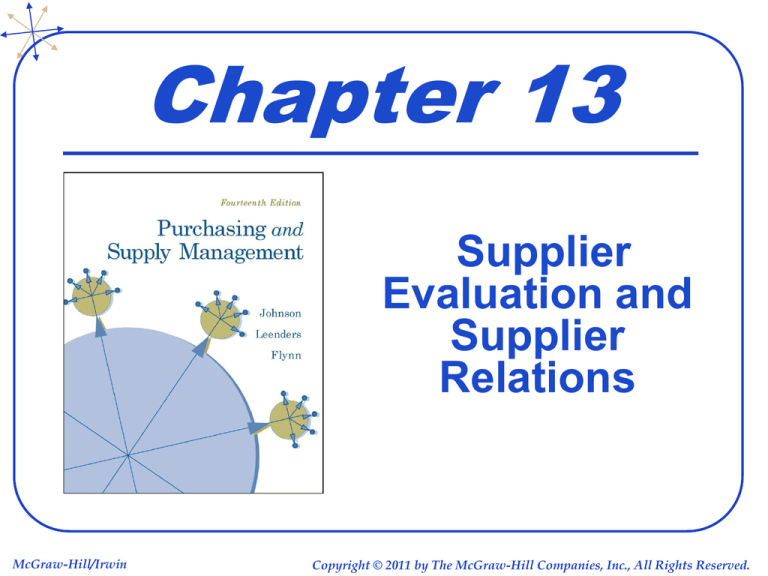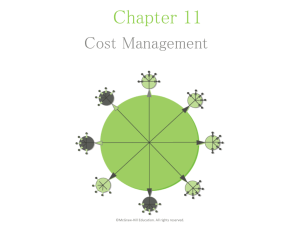
Chapter 13
Supplier
Evaluation and
Supplier
Relations
McGraw-Hill/Irwin
Copyright © 2011 by The McGraw-Hill Companies, Inc., All Rights Reserved.
13 - 2
Example of a Formal Supplier
Evaluation Rating System
Excellent:
Good:
Fair:
Poor:
a.
b.
c.
d.
e.
f.
Meets delivery dates without expediting.
Requested delivery dates are usually accepted.
Usually meets shipping dates without substantial follow-up.
Often is able to accept requested delivery dates.
Shipments sometimes late, substantial amount of follow-up required.
Shipments usually late, delivery promises seldom met, constant expediting
required.
13 - 3
Weighted Point Evaluation
Systems
Identify suppliers
•
Important suppliers and/or critical goods and services
Identify factors or criteria for evaluation
Determine the importance of each factor
Establish a system for rating each supplier on each
factor
13 - 4
Customer Satisfaction and
Supplier Performance
Customer Satisfaction
Strategic
Needs
Traditional
Needs
Suppliers
Other Additional
Needs
13 - 5
Purchaser-Supplier Satisfaction
Model
13 - 6
Purchaser-Supplier Satisfaction Model:
Congruent and Noncongruent
Perceptions
13 - 7
Buyer-Supplier Relationship:
Investment Versus Rewards
Obtained
13 - 8
View of Buyer-Supplier Relationships
Partnership
Traditional
Lowest price
Specification-driven
Short-term, reacts to market
Trouble avoidance
Purchasing’s responsibility
Tatical
Little sharing of information
Total cost of ownership
End-customer driven
Long-term
Opportunity maximization
Cross-functional teams and top
management involvement
Strategic
Both supplier and buyer on both sides
share short- and long-term plans
Shared risk and opportunity
Standardization
Joint ventures
Share data
13 - 9
The Deployment Path to
Partnership
1. Supplier Assessment
(Potential)
2. Supplier Improvements
3. Supplier Rationalization
4. Supplier Alignment
Supplier Partnership
13 - 10
Some Indicators of a Successful
Partnering Effort
Formal communication processes
Commitment to our suppliers’ success
Mutual profitability
Stable relationships, not dependent on a few personalities
Consistent and specific feedback on supplier performance
Realistic expectations
Employee accountability for ethical business conduct
Meaningful information sharing
Guidance to supplier in defining improvement efforts
Non-adversarial negotiations and decisions based on total
cost of ownership







